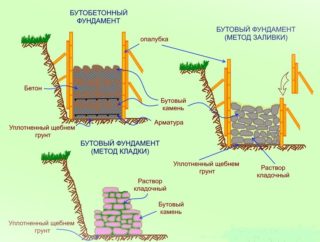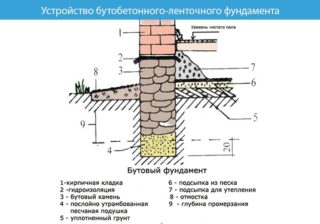The rubble foundation has been known in construction for several millennia. Natural stone was used for the construction of residential buildings, household structures, temples and even fortresses. Today, this material is somewhat supplanted by concrete, but still does not lose its popularity. The buta foundation has many positive characteristics, but there are certain difficulties in its construction.
Features of laying rubble foundation
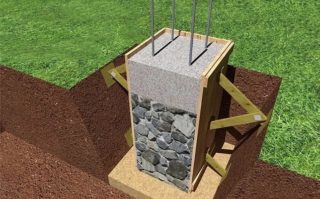
The stone base for the house is a prefabricated structure consisting of large fragments, the gaps between which are filled with small fragments, and the finished masonry is filled with liquid cement mortar. The composition of the rubble foundation is similar to concrete, but only with a larger filler. The kneading process has been replaced by the sequential addition of material directly on site. Since large stones are used in construction, connected with an adhesive, the strength of such a base will be sufficient to withstand the weight of even a very massive building. The weight factor at home also plays a role. The larger it is, the better the masonry is compacted and its reliability increases.
Bout is a hard rock of volcanic origin. The material varies in color, structure, size, configuration and specific gravity.
The rubble stone for the foundation is divided into the following categories:
- ragged - has an irregular contour, many chips and oblique edges;
- bedded - differs in an oblong shape, with flat surfaces;
- flagstone - relatively regular geometric configuration with parallel sides;
- cobblestone - has a rounded shape and small size, not exceeding 35 cm.
The stones used in construction must have a length of up to 50 cm and a weight of up to 30 kg.
Choosing a quality stone
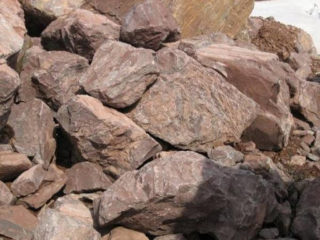
Since the strip rubble foundation experiences high vertical and horizontal loads, the material for it must be distinguished by its strength and integrity. Theoretically, the stone can be collected in the field, on the banks of water bodies or in quarries. However, several tons of rock will be required, it needs to be brought in and washed. It is much easier, faster and more profitable to purchase the required amount of buta from the nearest supplier.
It is imperative that the material must be checked before purchasing.
Quality is assessed according to the following criteria:
- Appearance. The cleanliness, surface texture, the absence of cracks and delamination are checked.
- Strength. Integrity must be maintained from being hit by a hammer or being thrown onto a hard surface.
- Density. A good stone emits a clear and clear sound when struck. A muffled sound indicates the presence of cracks and voids.
It is recommended to study the color range of the rock. It is desirable that it be in the same key and match the design of the site.
Advantages and disadvantages of a rubble base
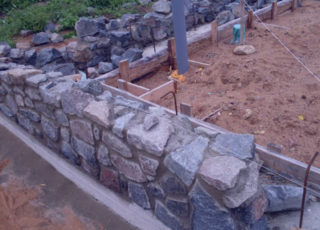
Like any building material, natural stone has its pros and cons.
Professionals note the following advantages:
- large margin of safety;
- high bearing capacity;
- presentable appearance of both fragments and masonry as a whole;
- ecological cleanliness;
- immunity to mold and mildew, not susceptible to decomposition and corrosion;
- water resistance and low hydrophobicity;
- resistance to temperature changes;
- practically unlimited service life.
Disadvantages of the material:
- tangible time spent on adjusting the fragments to the desired size;
- the difficulty of performing masonry from stones of non-standard shape;
- significant weight of buta;
- the inability to use for the construction of multi-storey buildings;
- difficulties in carrying out repairs, since the masonry consists of irregularly shaped fragments.
Analysis of the strengths and weaknesses of the technology will make it possible to make an optimal decision regarding the appropriateness of its choice and the method of implementation.
Common styling options for buta
Rubble stone in the foundation can be laid using the following technology:
- Under the bracket. This design is distinguished by a presentable appearance, since the masonry is even and the edges of the stone are clearly visible. To create, a template (bracket) and a calibrated bottle up to 25 cm in size are used. The base is erected in a trench below the freezing point, and reinforced rubble pillars are made at the corners. Each row is sprinkled with stone chips and then poured with cement mortar so that it remains inside. Sagging on the outer surface is immediately removed.
- Under the shoulder blade. This technique resembles working with a brick. Elongated stones are selected, which are stacked in rows on a cement mortar. A dressing is done, and the fragments are alternated in tiers, keeping within the length and width. From above, the masonry is fixed with an armored belt.
- For filling. The simplest, but no less reliable way of making a foundation. The stones are not sorted, but only cleaned of dirt. The material is loaded in tiers into the formwork, rammed and poured with concrete. Then the process is repeated, the solution is compacted with a vibrator. The technology is of the highest strength, but the aesthetic side fades into the last place.
When building a house, any method of stone laying can be used. When erecting a facade, it is advisable to use a device under a bracket. On the sides and from the rear, it is permissible to lay the bottle with a fill or under the shoulder blade.
Work on the strip rubble foundation
Step-by-step instructions for backing up the foundation:
- Carry out the markup. Install the stakes, stretch the cord, check the dimensions along straight lines and diagonals.
- Dig a trench with the calculation of laying the lower part of the support system deeper than the freezing point.
- Pour layers of sand and gravel, moisten them, level and compact.
- Install a waterproofing layer. Considering that the boot has sharp edges, it is better to use roofing material, placing it in 2-3 layers.
- Install the formwork. If the soil is dense and stable, this step can be skipped.
- Carry out the laying according to the selected specification.
Since there is a cement mortar in the masonry, the foundation must stand up to 28 days for the structure to acquire density and solidity.
A rubble foundation can only be built in dense soil with a low level of groundwater. If the formwork is not installed, the walls of the trench must be covered with dense cellophane. This will prevent the soil from absorbing the water in the solution.
The optimal ratio of concrete and stone is 50:50, the minimum concentration of rubble cannot be lower than 40%. The addition of granite screening and fine (up to 25 mm) crushed stone helps to strengthen the concrete.
When laying, the stone must be tamped with a sledgehammer and a heavy hammer.The material is strong enough to withstand even strong impacts without consequences.

